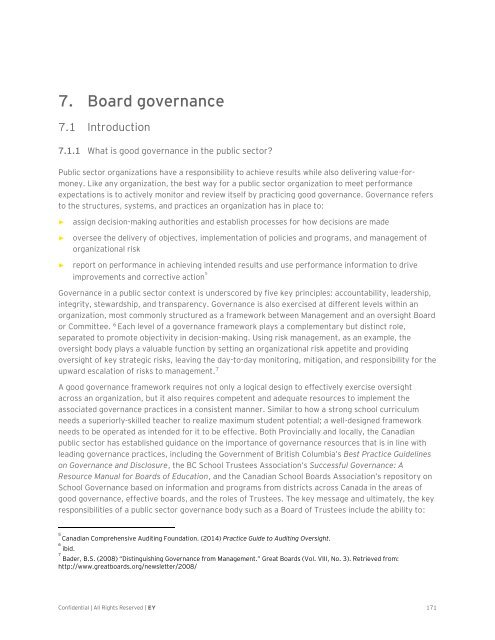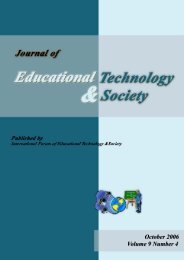DownloadAsset?assetId=F14FC0EBB1C24FAC93A09302BE386549&filename=moe_vsb_review_report_june_2015
DownloadAsset?assetId=F14FC0EBB1C24FAC93A09302BE386549&filename=moe_vsb_review_report_june_2015
DownloadAsset?assetId=F14FC0EBB1C24FAC93A09302BE386549&filename=moe_vsb_review_report_june_2015
You also want an ePaper? Increase the reach of your titles
YUMPU automatically turns print PDFs into web optimized ePapers that Google loves.
7. Board governance<br />
7.1 Introduction<br />
7.1.1 What is good governance in the public sector?<br />
Public sector organizations have a responsibility to achieve results while also delivering value-formoney.<br />
Like any organization, the best way for a public sector organization to meet performance<br />
expectations is to actively monitor and <strong>review</strong> itself by practicing good governance. Governance refers<br />
to the structures, systems, and practices an organization has in place to:<br />
►<br />
►<br />
►<br />
assign decision-making authorities and establish processes for how decisions are made<br />
oversee the delivery of objectives, implementation of policies and programs, and management of<br />
organizational risk<br />
<strong>report</strong> on performance in achieving intended results and use performance information to drive<br />
improvements and corrective action 5<br />
Governance in a public sector context is underscored by five key principles: accountability, leadership,<br />
integrity, stewardship, and transparency. Governance is also exercised at different levels within an<br />
organization, most commonly structured as a framework between Management and an oversight Board<br />
or Committee. 6 Each level of a governance framework plays a complementary but distinct role,<br />
separated to promote objectivity in decision-making. Using risk management, as an example, the<br />
oversight body plays a valuable function by setting an organizational risk appetite and providing<br />
oversight of key strategic risks, leaving the day-to-day monitoring, mitigation, and responsibility for the<br />
upward escalation of risks to management. 7<br />
A good governance framework requires not only a logical design to effectively exercise oversight<br />
across an organization, but it also requires competent and adequate resources to implement the<br />
associated governance practices in a consistent manner. Similar to how a strong school curriculum<br />
needs a superiorly-skilled teacher to realize maximum student potential; a well-designed framework<br />
needs to be operated as intended for it to be effective. Both Provincially and locally, the Canadian<br />
public sector has established guidance on the importance of governance resources that is in line with<br />
leading governance practices, including the Government of British Columbia’s Best Practice Guidelines<br />
on Governance and Disclosure, the BC School Trustees Association’s Successful Governance: A<br />
Resource Manual for Boards of Education, and the Canadian School Boards Association’s repository on<br />
School Governance based on information and programs from districts across Canada in the areas of<br />
good governance, effective boards, and the roles of Trustees. The key message and ultimately, the key<br />
responsibilities of a public sector governance body such as a Board of Trustees include the ability to:<br />
5<br />
Canadian Comprehensive Auditing Foundation. (2014) Practice Guide to Auditing Oversight.<br />
6<br />
ibid.<br />
7<br />
Bader, B.S. (2008) “Distinguishing Governance from Management.” Great Boards (Vol. VIII, No. 3). Retrieved from:<br />
http://www.greatboards.org/newsletter/2008/<br />
Confidential | All Rights Reserved | EY 171












